Beware the lists
We’ve all been there - there is a listing on a blocklist and the panic kicks in… and then nothing really happens. Not all blocklist are equal and considering there are hundreds of them it should not be surprising. Some blocklists are simply more important and some might be more relevant to your particular target group. Whatever your point of view one thing is certain - blocklisting is a signal of something significant no matter what the impact. Most likely you also use some service to monitor these blocklists (which is definitely not good for your mental health) but what if I told you there are a whole lot of listings you are missing? Agreed - this is also not good for your mental health but better now then never...
We all make sure to have our IPs monitored and that is really important but in my experience it’s rarely the sending IP that will cause you headaches (assuming you are not a spammer here). In my 20+ years in the industry I did not come across a blocklisting that could not be resolved within minutes as it was caused by a false positive. Yes it’s inconvenient and stressful but easily resolved if you are a good sender. Usually it’s easier to resolve blocklistings with large operators like Spamhaus or Abusix then small/regional ones like PolSpam. Back to the point - it’s not your IPs that will cause you trouble - it’s the IPs you don’t control and you never considered monitoring.
We are often too focused on our IPs, our domain, our reputation… sounds a bit self-centered right? Your emails are a large collection of reputations and you should not forget about that. Images hosted on a CDN of your ESP? There are some IPs and domain reputation to be considered. Countdown timer from a 3rd party service? Another image pointing to a domain and IP reputation. Link to your partner website? Link to facebook, linkedin, twitter, image elements added by your designer? It just keeps adding up… and we are not done! Every single domain that you refer to in your email has a DNS server and each has an IP address. Every single host has an IP. See where I’m going here?
In the past 2 years I haven’t been dealing with a single blocklisting of our sending IPs (not counting Microsoft’s very random IP blockings). What I did have to deal with were blocklisting of many 3rd party hosts, networks and services that were linked in the bodies of emails. Some of these blocklistings will result in messages being bounced - that is the best possible outcome as you do get a signal you can respond to. In many cases the messages were not bounced - they were either spam-foldered or just vanished. What was the content you ask? The usual newsletters with countdown timers (service domain blocklisted), messages with images hosted in amazon bucket (IP range blocked for abuse), DNS server IPs of a registrar blocked for supporting abusive domain registrations… All causes were out of our or our client’s control.
Now that you know it’s time to set up some more blocklist monitors. Start monitoring all your domains and the most common domains and hosts referenced in your emails. Add the IPs of your DNS servers and hosts used for image sources and your website. If you have partners you do cross-promotion with make sure to monitor their domains and IPs as well.
I take it by now you realize your list of monitored items will grow significantly and it should because it will help you prevent the next disaster (and hopefully a heart attack as well). For your own mental health’s sake you should make sure not to be the one awaiting those notifications. Happy holidays!










